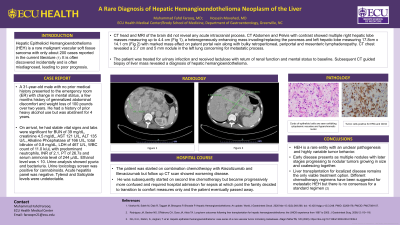Back


Poster Session C - Monday Afternoon
Category: Liver
C0550 - A Rare Diagnosis of Hepatic Hemangioendothelioma Neoplasm of the Liver
Monday, October 24, 2022
3:00 PM – 5:00 PM ET
Location: Crown Ballroom

Has Audio

Muhammad Farooq, MD
East Carolina University Brody School of Medicine
Greenville, NC
Presenting Author(s)
Muhammad Farooq, MD
East Carolina University Brody School of Medicine, Greenville, NC
Introduction: Hepatic Epithelioid Hemangioendothelioma (HEH) is a rare malignant vascular soft tissue sarcoma with only about 200 cases reported in the current literature.It is often discovered incidentally and is often misdiagnosed, leading to poor prognosis.
Case Description/Methods: A 31-year-old male with no prior medical history presented to the emergency room (ER) with change in mental status, a few months history of generalized abdominal discomfort and weight loss of 100 pounds over two years. He had a history of prior heavy alcohol use but was abstinent for 4 years. On arrival, he had stable vital signs and labs were significant for BUN of 39 mg/dL, creatinine 4.5 mg/dL, AST 121 U/L, ALT 135 U/L, Alkaline Phosphatase of 166 U/L, total bilirubin of 0.8 mg/dL, LDH of 467 U/L, WBC count of 11.0 k/uL with predominant neutrophils, INR of 2.1, PT of 26.7s and serum ammonia level of 244 µ/dL. Ethanol level was < 10. Urine analysis showed pyuria and bacteriuria. Urine toxicology screen was positive for cannabinoids. Acute hepatitis panel was negative. Tylenol and Salicylate levels were undetectable. CT head and MRI of the brain did not reveal any acute intracranial process. CT Abdomen and Pelvis with contrast showed left sided renal stone, multiple right hepatic lobe masses measuring up to 4.4 cm, a heterogeneously enhancing mass invading/replacing the pancreas and left hepatic lobe measuring 17.8cm x 14.1 cm with marked mass effect on patent portal vein along with bulky retroperitoneal, periportal and mesenteric lymphadenopathy. CT chest revealed a 2.7 cm and 5 mm nodule in the left lung concerning for metastatic process.The patient was treated for urinary infection and ureteral stone and received lactulose with return of renal function and mental status to baseline. Subsequent CT guided biopsy of liver mass revealed a diagnosis of hepatic hemangioendothelioma. The patient was started on combination chemotherapy with Atezolizumab and Bevacizumab but follow up CT scan showed worsening disease. He was subsequently started on second line chemotherapy but became progressively more confused and required hospital admission for sepsis at which point the family decided to transition to comfort measures only and the patient eventually passed away.
Discussion: HEH is a rare entity with an unclear etiology. Liver transplantation for localized disease remains the only viable treatment option. Different chemotherapy regimens have been suggested for metastatic HEH but there is no general consensus for a standard regimen.

Disclosures:
Muhammad Farooq, MD. C0550 - A Rare Diagnosis of Hepatic Hemangioendothelioma Neoplasm of the Liver, ACG 2022 Annual Scientific Meeting Abstracts. Charlotte, NC: American College of Gastroenterology.
East Carolina University Brody School of Medicine, Greenville, NC
Introduction: Hepatic Epithelioid Hemangioendothelioma (HEH) is a rare malignant vascular soft tissue sarcoma with only about 200 cases reported in the current literature.It is often discovered incidentally and is often misdiagnosed, leading to poor prognosis.
Case Description/Methods: A 31-year-old male with no prior medical history presented to the emergency room (ER) with change in mental status, a few months history of generalized abdominal discomfort and weight loss of 100 pounds over two years. He had a history of prior heavy alcohol use but was abstinent for 4 years. On arrival, he had stable vital signs and labs were significant for BUN of 39 mg/dL, creatinine 4.5 mg/dL, AST 121 U/L, ALT 135 U/L, Alkaline Phosphatase of 166 U/L, total bilirubin of 0.8 mg/dL, LDH of 467 U/L, WBC count of 11.0 k/uL with predominant neutrophils, INR of 2.1, PT of 26.7s and serum ammonia level of 244 µ/dL. Ethanol level was < 10. Urine analysis showed pyuria and bacteriuria. Urine toxicology screen was positive for cannabinoids. Acute hepatitis panel was negative. Tylenol and Salicylate levels were undetectable. CT head and MRI of the brain did not reveal any acute intracranial process. CT Abdomen and Pelvis with contrast showed left sided renal stone, multiple right hepatic lobe masses measuring up to 4.4 cm, a heterogeneously enhancing mass invading/replacing the pancreas and left hepatic lobe measuring 17.8cm x 14.1 cm with marked mass effect on patent portal vein along with bulky retroperitoneal, periportal and mesenteric lymphadenopathy. CT chest revealed a 2.7 cm and 5 mm nodule in the left lung concerning for metastatic process.The patient was treated for urinary infection and ureteral stone and received lactulose with return of renal function and mental status to baseline. Subsequent CT guided biopsy of liver mass revealed a diagnosis of hepatic hemangioendothelioma. The patient was started on combination chemotherapy with Atezolizumab and Bevacizumab but follow up CT scan showed worsening disease. He was subsequently started on second line chemotherapy but became progressively more confused and required hospital admission for sepsis at which point the family decided to transition to comfort measures only and the patient eventually passed away.
Discussion: HEH is a rare entity with an unclear etiology. Liver transplantation for localized disease remains the only viable treatment option. Different chemotherapy regimens have been suggested for metastatic HEH but there is no general consensus for a standard regimen.

Figure: Liver mass
Disclosures:
Muhammad Farooq indicated no relevant financial relationships.
Muhammad Farooq, MD. C0550 - A Rare Diagnosis of Hepatic Hemangioendothelioma Neoplasm of the Liver, ACG 2022 Annual Scientific Meeting Abstracts. Charlotte, NC: American College of Gastroenterology.
